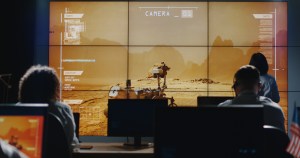 NASA wants help finding what cities inhabit photos taken in the dark from outer space. (Image courtesy of the Earth Science and Remote Sensing Unit, NASA Johnson Space Center)
NASA wants help finding what cities inhabit photos taken in the dark from outer space. (Image courtesy of the Earth Science and Remote Sensing Unit, NASA Johnson Space Center)Can you tell what city that is in the picture above*, just by looking at its lights? NASA would like to hear from you.
The Complutense University of Madrid (UCM) is teaming with NASA for a project that will allow scientists to make sense of the millions of photos NASA has collected since its missions to Mercury in the 1960s.
The primary goal of the project, dubbed Cities at Night, is to create a working directory from night-time images so the media, academics and the public can use them for other projects. NASA said once the photos are catalogued, they will be used to discover ways to “save energy, contribute to better human health and safety and improve our understanding of atmospheric chemistry.”
 A night-time photo taken from the International Space Station that shows the light different between North Korea and South Korea. (Courtesy: NASA)
A night-time photo taken from the International Space Station that shows the light different between North Korea and South Korea. (Courtesy: NASA)“Anyone can help,” said Alejandro Sanchez, a Ph.D. student at UCM, in a statement. “In fact, without the help of citizens, it is almost impossible to use these images scientifically. Algorithms cannot distinguish between stars, cities, and other objects, such as the moon. Humans are much more efficient for complex image analysis.”
Cities at Night has been broken up into three smaller components that come with varying degrees of difficulty for public participants. Dark Skies takes photos snapped from the International Space Station and asks participants to differentiate the photos between cities, stars or other objects. Night Cities asks scientists to identify points and match them to positions on maps, which will in turn be used to create light maps of cities around the globe. Lost at Night is asking for people to take extremely hard-to-identify night-time images and label population centers in a circle 310 miles around the photographed area.
“We don’t know which direction the astronaut pointed the camera, only where the station was at the time the image was taken,” Sanchez explained. “Some images are bright cities but others are small towns. It is like a puzzle with 300,000 pieces.”
The images all come from NASA’s Gateway to Astronaut Photography of Earth, the largest collection of Earth images taken by astronauts. Of the 1.8 million photos in the database, 1.3 million have been snapped from the International Space Station, with approximately 30 percent taken at night.
The images are possible thanks to the European Space Agency’s NightPod, a camera that takes the speed of the ISS (17,500 mph) and Earth’s rotation into account while taking photos. Prior to 2003, when NightPod’s predecessor was launched, night-time images from ISS were often blurry. NightPod allows for image clarity, but it does not track the location of each photo.
Scientists believe there are multiple lessons that can be taken from the photos, just like the energy efficiency or economic health of a particular city.
“A clear example is comparison of Madrid and Berlin,” Sanchez said. “Madrid is the capital of Spain, a country facing a major economic crisis. It is much brighter in astronaut images than Berlin, the capital of Germany, the country with the healthiest economy in Europe. Perhaps that is an indication that Germany more efficiently manages its resources. The images can provide evidence and data to verify that.”
 A night-time image of the Iberian Pensinsula. Madrid, Spain sits in the middle of the pictured land mass. (Courtesy: NASA)
A night-time image of the Iberian Pensinsula. Madrid, Spain sits in the middle of the pictured land mass. (Courtesy: NASA)Hundreds of volunteers have already catalogued more than 20,000 images, with another 4,000 being logged since the project’s announcement last week. However, NASA said it hopes to have each photo classified multiple times in order to ensure accuracy.
To participate in or learn more about the Cities at Night project, you can visit its website.
*Moscow, Russia






